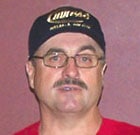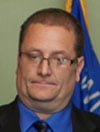Two assistant state legislative directors were elevated to lead their respective states’ legislative boards after a pair of retirements at the end of 2018.
In Oregon, Glenn Carey, a member of Local 1841 and the state’s assistant SLD since March 2016, took over with the Jan. 1 retirement of Randy Russ.
Russ, of Local 1574, joined the union in 1999 and served just short of seven years as Oregon’s SLD.
“When Randy talked, people listened,” Carey said. “That’s Randy…not a lot of banter, but when he talked, we hung on every word. We listened. Most staunch union man I’d ever seen and (he) was a big brother to me.
“I am hoping to do a good job for SMART TD and keep the level of professionalism just like Randy did.”
Carey says two-person crew legislation similar to what was passed in California will be a priority in Oregon.
“We will get it,” he said. “The timing is right.”
In Wisconsin, William “Andy” Hauck succeeds Craig Peachy, who also retired effective Jan. 1. Hauck began as assistant SLD in April 2016 and is a member of Local 583.
Hauck said he’s taking over the state legislative board at a good time.
“We have a new governor in Wisconsin — we’re ‘Scott free’,” he quipped, referring to the anti-union former Gov. Scott Walker, who enacted right-to-work-for-less and other anti-union initiatives during his terms.
Wisconsin is among four states that have passed state two-person crew legislation, so Hauck’s focus will be on bringing legislation forward on issues including taxi-cab legislation covering rail worker transportation; rail inspection reforms through the state Commissioner of Railroads Office; legislation covering safety lighting in rail yards and ensuring that full Positive Train Control (PTC) interface access is available to conductors.
“The regulation states that ALL crew members will be trained and have the capability to interact with the safety overlay system of PTC,” Hauck said.
Hauck’s predecessor, Peachy, hired out with the Soo Line railroad in 1974 and had his rail career disrupted a number of times because of layoffs. He returned for good in 1990 with the Wisconsin Central Ltd., a subsidiary of Canadian National that was successfully organized by the United Transportation Union in 1997.
Peachy, of Local 583 (Fond du Lac, Wis.), got involved as a local legislative representative, eventually being elected state legislative director in 2012 and then re-elected in 2016.
“It has been an honor and privilege to have leaders like Brothers John Risch and James Stem, who were always there to guide and direct me to be the best state legislative director that I could be,” Peachy said in a letter announcing his retirement. “The SMART TD Legislative Department is second to none due to our past and present elected leadership.”
SMART TD wishes Peachy and Russ the best in their retirements and Carey and Hauck success in their work to serve our brothers and sisters.
Tag: Craig Peachy

In a letter to the editor published Oct. 24 in the Fond du Lac Reporter, SMART Transportation Division’s Wisconsin State Legislative Director Craig Peachy wrote a response to an article that was published Sept. 13 entitled, “More trains lead to traffic delays at crossings.”
“A train blocked the 175 Highway crossing for more than five hours on Sept. 7.
“Almost immediately, three local misguided Republican Congressman (Tom Petri, Jim Sensenbrenner, Sean Duffy) misdiagnosed the problem and proposed Congress pass a law that would require railroad workers to work longer hours.
“The problem with this incident and almost all like it is not the fault of the crew on the train. Rather, it lies with bad decisions by railroad managers.
“The train blocked the crossing because a railroad manager refused to communicate with the train crew and forced them to pull the train ahead to a point where it blocked the highway crossing, knowing full well there were places where this train could have parked that would not have blocked a crossing.
“Railroads are ever increasing train lengths that are commonly as long as 9,000 to 10,000 feet, when road crossings are generally located on section lines approximately 5,280 feet or a mile apart. Add to the mix that some railroads want to go to one person on a train, which would make it impossible to cut road crossings. All of this means Wisconsinites can just plan on being stuck for hours most everywhere.
“What is the solution? Better management decisions, shorter trains and the continuation of at least two persons on every train.
“As a 23-year operating railroad employee, I can assure you the last thing a train crew wants to do is block a crossing longer than is absolutely necessary. Train crews have family, friends and neighbors that live in the community and may need emergency assistance at any given time. Blocking road crossings for hours in a non-emergency situation is not only immoral, but should not be tolerated by Wisconsinites.”

